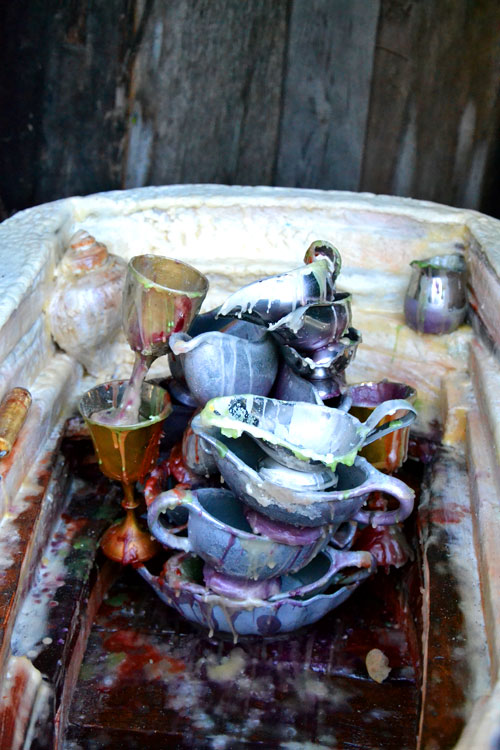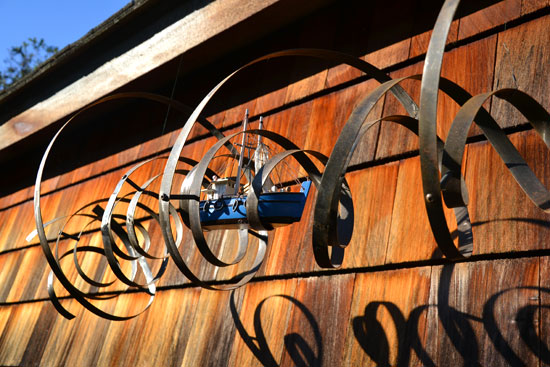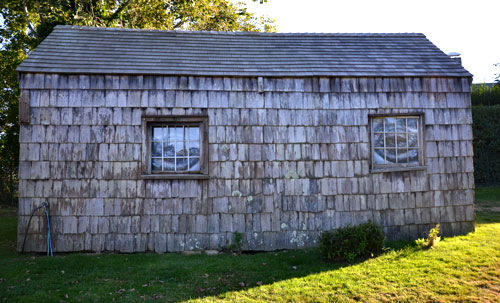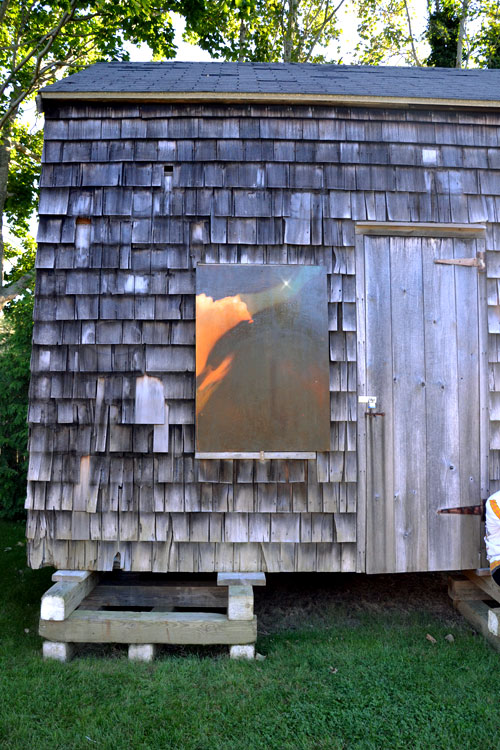If you waited, you might have missed it. "The Moby Project" swooped in and claimed the historic Mulford Farm in East Hampton for 10 days only as a sprawling site for contemporary art. The exhibition, made up of site-specific installations, forms the centerpiece of a creative project that combines literature with visual art and performance in three separate events unfolding in October 2013. Each program features artists interpreting Herman Melville's Moby-Dick; or The Whale.
Taking it a step further, "The Moby Project" exhibition, curated and installed by project founder Janet Goleas, had artists channel the American classic and then link their art to a historic building or site-specific area at Mulford Farm in East Hampton. Mulford Farm, ca 1680, is considered one of America's most significant, intact, English Colonial farmsteads, according to the East Hampton Historical Society, and is listed on the National Register of Historic Places.
Located a long stone throw away from the sea, it also provides the perfect location to marry literature, art, history and life lived on the ocean.
.

"A Boggy Picture" by Clayton Orehek, 2013. Mixed media, 23 x 88 x 5 inches.
.
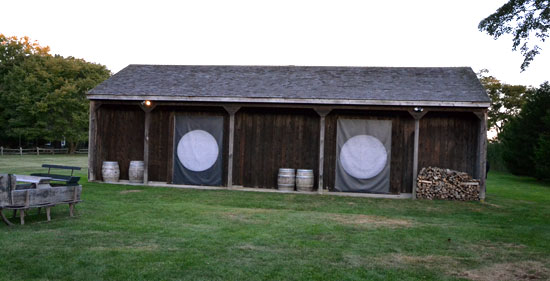
"Bob Goes Black" and "Black Goes Black 2" by Brian Gaman, 2013. Print on perforated vinyl, 112 x 84 inches.
.
Invited artists to "The Moby Project" included Junko Sugimoto, Bonnie Rychlak, Don Christensen, Judy Richardson, Joe Pintauro, Hope Sandrow, Jon Bocksel, Chris Lidrbauch, Dennis Oppenheim (1938-2011), Amanda Church, Clayton Orohek, Steven B. Miller, Brian Gaman, Bryan Hunt and Lucy Winton.
Themes explored by the art include “whiteness, the sea, mania, invisibility, superstition, turmoil and the whale,” according to Goleas.
.
.
.
After examining the art on view, many pieces seemed to have been pulled straight from Melville's novel like a harpoon's path on the way to its mark. Whales, boats, tumultuous seas and the moon were prevalent artwork references. But like Moby-Dick; or The Whale, it's the layers that captivate after moving past the obvious to exploring the depths of what was entailed in making the work and the limits pushed by the artist.
For instance, Hope Sandrow's nine-minute video installation Selections from Untitled Observations, spacetime, 2006 depicts a rising and setting moon projected onto the exposed flesh of the artist. The image is actually the moon, explained Sandrow, captures as a reflection of a projection from a high-powered telescope.
The observable trajectory traveled by the moon in a typical sky was condensed to reflect the proportions of the new skin-colored "sky" it found itself upon. The video is designed to throw viewers off their balance by the unusual presentation of an actual image of the planet-size moon presented on the human-size soles of Sandrow's feet.
"I like to question everything," said Sandrow. "What we're told we see and what we're told to expect."
In this way, the video connects to Sandrow's art practice, in general. The video was three years in the making and required Sandrow to sit still for hours while the move traveled its natural path in the sky, she said.
The piece was selected for "The Moby Project" by Goleas as the characters in Moby-Dick would have navigated dark waters by moonlight as they searched for the white whale, said Sandrow. The video was installed inside the window well of one of the historic barns and was viewed by standing outside of the barn and looking "in," reversing the typical experience of being inside a building and looking through the window to see the world outside.
Bonnie Rychlak's artworks were also labor-intensive while appearing to a simple construction. She makes "grates" through the labor-intensive process of cast wax. They, too, can take years to construct. While the object her art mimics are sturdy and designed to be trod upon by humans and animals and to withstand pressure from rushing waters, Rychlak's objects are not.
"The idea is to take something that's fragile and have it work in another format," said Rychlak. "There's tension there on whether it will work or not and what's going to happen."
.
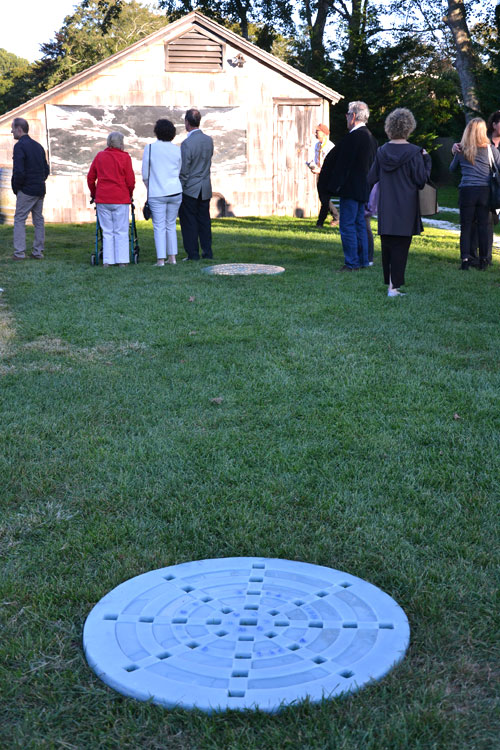
"Down the Drain in Sag Harbor" and "East Hampton Sewer System" by Bonnie Rychiak, 2013. Hand carved cast wax, each 2.50 x 36 inches.
.
Rychlak's artworks are expected to be transformed or degrade or even break from exposure to weather, impact from natural conditions, or from human trampling, she said.
Two sculptures--meant to be installed at ground level--were selected for The Moby Project. Down the Drain in Sag Harbor and East Hampton Sewer System refer to Hamptons in modern times. Metaphorically, the sculptures conjure wondering about what lies unseen beneath and the elemental residue that gets left behind, said Rychlak.
The sculpture's material - wax - has a reference to material that was used for illumination, in Captain Ahab's time, she said.
.
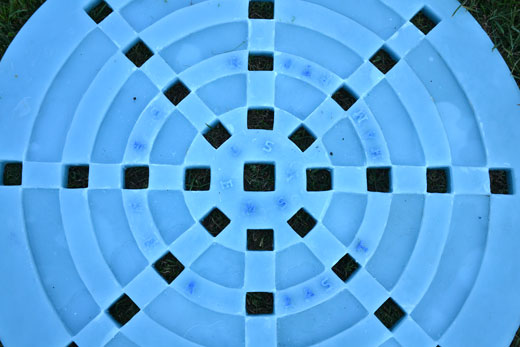
Detail of "Down the Drain in Sag Harbor" by Bonnie Rychiak, 2013. Hand carved cast wax, 2.50 x 36 inches.
.

"East Hampton Sewer System" by Bonnie Rychiak, 2013. Hand carved cast wax, 2.50 by 36 inches.
.
Joe Pintauro's Ocean Vortex also held surprises. The image was created by duplicating and transposing the same photograph Pintauro took of open teeming ocean, he said. When one image was flipped and matched to the original, the effect became menacing.
.
.
One of the main attractions of "The Moby Project" was a site-specific installation made especially for the exhibition by Junko Sugumoto. Working only with paper and fishing line, Sugumoto created a sprawling sculptural work suspended from the ceiling of a historic barn. Moby Dick was designed to conjure the swells and curling of an ocean that isn't always hospitable, she said.
The installation was a reach for Sugumoto as this was the first time her paper installations were designed to curve and imply motion. The paper pieces were made off-site but the installation was assembled on site with its final form unknown until after fully installed.
"I had an idea, as I took measurements, but I wasn't sure how it was going to turn out," said Sugumoto.
She began making Moby Dick in February. The piece is made of 1,500 paper tubes that are each hand rolled.
The work is connected to Melville's novel through its shape and its implied movement. Emotion is conjured through the combination of color, the horizontal expanse and the suspended installation which allows visitors to feel what may be a crashing wave hovering immediately above them.
"It is dark but beautiful," said Sugumoto.
.
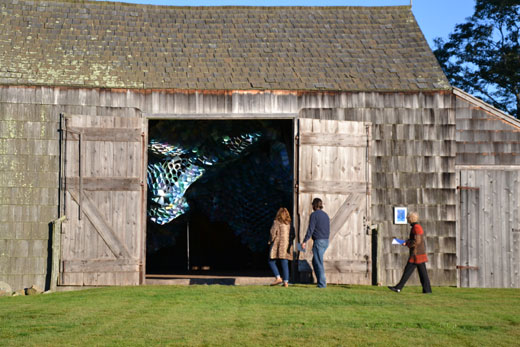
"Moby Dick" by Junko Sugumoto, 2013, installed inside historic barn at Mulford Farm. Paper and fishing line.
.

Detail of "Moby Dick" by Junko Sugumoto, 2013. Paper and fishing line.
.
Where is M. Dick by Steve B. Miller also had an exhibition-only twist. Stepping away from his typically methodology, Miller added a miniature boat to the center of his steel sculpture. His works are designed to be as much about motion and lightness created in steel as the shadows that form with shifting light as it strikes the sculpture, said Miller.
Adding a boat to his curved sculpture that conjured ocean waves seemed apropos for "The Moby Project," he said.
.
.
"The Moby Project" was one of four site-specific outdoor contemporary art projects held this summer on the East End. Each of them presented art that reacted to the space and to the community. Other installations are “Pop Up 1: MONTAUK” in Montauk presented by Fabiola Beracasa and Art Production Fund in association with Gary Carrion-Murayari and Joyce Sitterly of the New Museum; "LAT. 41° 7′ N., LONG. 72° 19′ W" in East Marion on the North Fork (outdoors and inside) curated and organized by Bob Nickas and presented by Martos Gallery of Chelsea and “The Expansive Field: Environmental Art by Christine Sciulli” installed on the grounds of the South Fork Natural History Museum (SoFo) in Bridgehampton.
Continue scrolling to see more art installed as part of "The Moby Project," curated and organized by Janet Goleas:
.
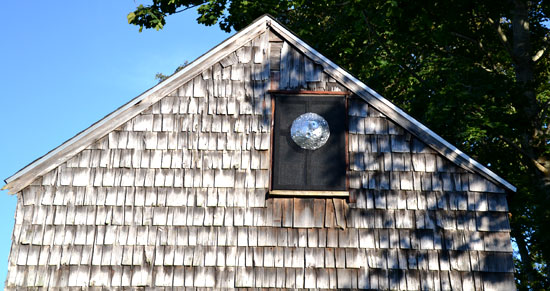
"Moon" by Bryan Hunt, 2012. Mixed media on screen.
.
.
.
.

"Chapter 135 The Chase Third Day" by Don Christensen, 2013. Sound installation, broadcast from the barn on left. "Moby Dick" by Junko Sugimoto, 2013. Paper and fishing line, installed in the barn on right.
.
.
.
___________________________________
BASIC FACTS: "The Moby Project" was presented from Sept. 27 to Oct. 8, 2013 at Mulford Farm, 10 James Lane, East Hampton, NY 11937. www.themobyproject.com. Its sister exhibition "Moby-Dick" continues through Oct. 18, 2013 at Neoteric Fine Art, 208 Main St., Amangasett, NY. www.neotericfineart.com. On Oct. 23, 2013, a dramatic reading of Herman Melville's Moby-Dick; or The Whale is part of an evening of art and dining at Almond's restaurant in Bridgehampton, NY.
RELATED STORIES: "Moby Dick, Interpreted"
______________________________________
Copyright 2013 Hamptons Art Hub LLC. All rights reserved.


